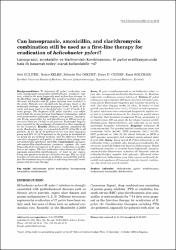| dc.contributor.author | Güliter S. | |
| dc.contributor.author | Keleş H. | |
| dc.contributor.author | Özkurt Z.N. | |
| dc.contributor.author | Cengiz D.U. | |
| dc.contributor.author | Kolukisa E. | |
| dc.date.accessioned | 2020-06-25T15:13:33Z | |
| dc.date.available | 2020-06-25T15:13:33Z | |
| dc.date.issued | 2005 | |
| dc.identifier.citation | Güliter, S., Keleş, H., Özkurt, Z. N., Cengiz, D. U., Kolukısa, E. (2005). Can lansoprazole, amoxicillin, and clarithromycin combination still be used as a first-line therapy for eradication of helicobacter pylori?. Turkish Journal of Gastroenterology, 16(1), 29 - 33. | en_US |
| dc.identifier.issn | 13004948 | |
| dc.identifier.uri | https://hdl.handle.net/20.500.12587/1844 | |
| dc.description | PubMed: 16252185 | en_US |
| dc.description.abstract | Background/aims: To determine H. pylori eradication rate with lansoprazole-amoxicillin-clarithromycin treatment regimen, which is the most frequently used as first-line therapy, in the Kirikkale region. Methods: One hundred and five patients (44 male, 61 female) with H. pylori infection were included in the study. Patients were divided into two groups based on the endoscopic findings: non-ulcer dyspepsia (n=84, 31 male, 53 female) and acute gastric or duodenal ulcer (n=21, 13 male, 8 female) groups. The diagnosis of H. pylori infection was confirmed if both the urease test and histological examination, which were performed on endoscopic biopsies, were positive. Lansoprazole 30 mg, amoxicillin 1 g, and clarithromycin 500 mg were given twice daily for 14 days to all patients. Endoscopic biopsies were repeated for the evaluation of eradication three months after the treatment. Results: Ninety-six patients completed the study. Eradication rates were found to be 45.8% (44 of 96) in all patients, 42.1% (32 of 76 patients) in the non-ulcer dyspepsia group and 60% (12 of 20 patients) in the gastric or duodenal ulcer group for per protocol analysis, and the difference between non-ulcer dyspepsia and gastric or duodenal ulcer groups was not statistically significant (p=0.208). Conclusions: Lansoprazole-amoxicillin-clarithromycin treatment regimen, the most frequently preferred regimen in H. pylori eradication, is ineffective in our region. The low eradication rates observed with lansoprazole-amoxicillin-clarithromycin, at least in our region, bring into question its use as a first-line therapy. The use of alternative treatment protocols or antibiotic susceptibility test before the treatment may be helpful in achieving successful eradication with first-line therapy. | en_US |
| dc.language.iso | eng | en_US |
| dc.rights | info:eu-repo/semantics/openAccess | en_US |
| dc.subject | Amoxicillin | en_US |
| dc.subject | Clarithromycin | en_US |
| dc.subject | Helicobacter pylori eradication | en_US |
| dc.subject | Lansoprazole | en_US |
| dc.title | Can lansoprazole, amoxicillin, and clarithromycin combination still be used as a first-line therapy for eradication of helicobacter pylori? | en_US |
| dc.type | article | en_US |
| dc.contributor.department | Kırıkkale Üniversitesi | en_US |
| dc.identifier.volume | 16 | en_US |
| dc.identifier.issue | 1 | en_US |
| dc.identifier.startpage | 29 | en_US |
| dc.identifier.endpage | 33 | en_US |
| dc.relation.journal | Turkish Journal of Gastroenterology | en_US |
| dc.relation.publicationcategory | Makale - Ulusal Hakemli Dergi - Kurum Öğretim Elemanı | en_US |
















